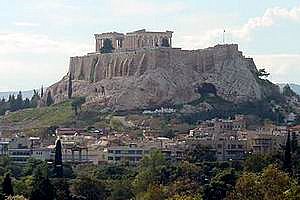 The Acropolis is the one historical site you can't miss. You can take a tour or wander up there yourself but during the summer, whatever you do, unless it is overcast, go early or late in the day. It can get very hot up there and gasping for breath can take way from your ability to marvel at the greatest of all archaeological sites. Getting to the Acropolis is easy and more pleasant than ever because the large avenues which border the south and west of the site (Apostolou Pavlou in Thission and Dionissiou Areopagitou in Makrianni) have been turned into giant pedestrian streets with cafes and restaurants and the walk is quite pleasant. From the Plaka and Monastiraki side it has always been a car-less, enjoyable walk and all you have to do is walk uphill from wherever you are and when you get to the top and there are woods instead of buildings, and steps, take a right.
The Acropolis is the one historical site you can't miss. You can take a tour or wander up there yourself but during the summer, whatever you do, unless it is overcast, go early or late in the day. It can get very hot up there and gasping for breath can take way from your ability to marvel at the greatest of all archaeological sites. Getting to the Acropolis is easy and more pleasant than ever because the large avenues which border the south and west of the site (Apostolou Pavlou in Thission and Dionissiou Areopagitou in Makrianni) have been turned into giant pedestrian streets with cafes and restaurants and the walk is quite pleasant. From the Plaka and Monastiraki side it has always been a car-less, enjoyable walk and all you have to do is walk uphill from wherever you are and when you get to the top and there are woods instead of buildings, and steps, take a right.
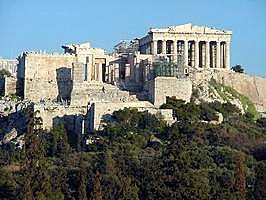 After climbing the steps you are at the entrance, or the Propylaea, which was completed in 432 just before the outbreak of the Peloponnesian wars. The main architect was Mnesicles, a colleague of Phidias. To your left is the Pinacotheca and a Hellenistic pedestal and on the right the tiny temple to Nike Athena or the Athena of Victory which commemorates the Athenians victory over the Persians. This small temple stands on a platform that overlooks the islands of Saronic Gulf and used to house a statue of Athena. It was dismantled by the Turks in 1686 so they could use the platform for a large cannon. It was rebuilt between 1836 and 1842 and again taken apart and rebuilt in 1936 when it was discovered that the platform was crumbing. If you looking from the propylaea towards Pireaus on a clear day you can see ships waiting outside the port of Pireaus, the islands and the mountains of the Peloponessos beyond.
After climbing the steps you are at the entrance, or the Propylaea, which was completed in 432 just before the outbreak of the Peloponnesian wars. The main architect was Mnesicles, a colleague of Phidias. To your left is the Pinacotheca and a Hellenistic pedestal and on the right the tiny temple to Nike Athena or the Athena of Victory which commemorates the Athenians victory over the Persians. This small temple stands on a platform that overlooks the islands of Saronic Gulf and used to house a statue of Athena. It was dismantled by the Turks in 1686 so they could use the platform for a large cannon. It was rebuilt between 1836 and 1842 and again taken apart and rebuilt in 1936 when it was discovered that the platform was crumbing. If you looking from the propylaea towards Pireaus on a clear day you can see ships waiting outside the port of Pireaus, the islands and the mountains of the Peloponessos beyond.
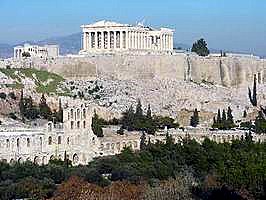 The Parthenon and other main buildings on the Acropolis were built by Pericles in the fifth century BC as a monument to the cultural and political achievements of the inhabitants of Athens. The term acropolis means upper city and many of the city states of ancient Greece are built around an acropolis where the inhabitants can go as a place of refuge in times of invasion. It's for this reason that the most sacred buildings are usually on the acropolis. It's the safest most secure place in town. As little as 150 years ago there were still dwellings on the Acropolis of Athens. Those of you who have read Aristophanes will recall that in Lysistrata the women have Athens barricaded themselves in the fortress in protest, being tired of their men going to war against Sparta. Depriving them of sex, cooking and care it was a terrific strategy that might even work today. Regardless, the play opened the door to the subject of sexual frustration in comedy and without it we might not have Woody Allen. Nowadays there are still protests which occasionally take place by site employees closing the Acropolis to tourists, some of whom have waited a lifetime to come to Greece. Thankfully these are rare and of short duration.
The Parthenon and other main buildings on the Acropolis were built by Pericles in the fifth century BC as a monument to the cultural and political achievements of the inhabitants of Athens. The term acropolis means upper city and many of the city states of ancient Greece are built around an acropolis where the inhabitants can go as a place of refuge in times of invasion. It's for this reason that the most sacred buildings are usually on the acropolis. It's the safest most secure place in town. As little as 150 years ago there were still dwellings on the Acropolis of Athens. Those of you who have read Aristophanes will recall that in Lysistrata the women have Athens barricaded themselves in the fortress in protest, being tired of their men going to war against Sparta. Depriving them of sex, cooking and care it was a terrific strategy that might even work today. Regardless, the play opened the door to the subject of sexual frustration in comedy and without it we might not have Woody Allen. Nowadays there are still protests which occasionally take place by site employees closing the Acropolis to tourists, some of whom have waited a lifetime to come to Greece. Thankfully these are rare and of short duration.
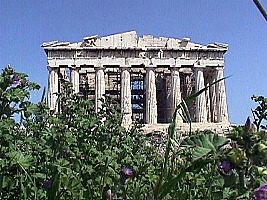 The best time to go up there is the late winter or spring when even this stone mountain is not immune to the proliferation of grass and wildflowers which seem to burst from every crack. Even in December, January and February the Acropolis can be surprisingly green. Even having seen a thousand photographs one is still not prepared for the immensity of the Parthenon. The building was designed by the architects Kallikrates and Iktinos as the home of the giant statue of Athena. It took 15 years to build and was completed in 438 BC and is probably the most recognizable structure in the world next to the golden arches of McDonalds. From a temple it became a church, a mosque and finally as a storage facility for Turkish gunpowder. In 1687 the Venetians bombarded it from below. A cannon ball hit the gun powder and blew it up.
The best time to go up there is the late winter or spring when even this stone mountain is not immune to the proliferation of grass and wildflowers which seem to burst from every crack. Even in December, January and February the Acropolis can be surprisingly green. Even having seen a thousand photographs one is still not prepared for the immensity of the Parthenon. The building was designed by the architects Kallikrates and Iktinos as the home of the giant statue of Athena. It took 15 years to build and was completed in 438 BC and is probably the most recognizable structure in the world next to the golden arches of McDonalds. From a temple it became a church, a mosque and finally as a storage facility for Turkish gunpowder. In 1687 the Venetians bombarded it from below. A cannon ball hit the gun powder and blew it up.
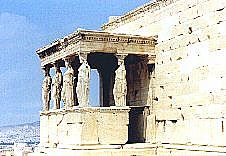 The Erecthion sits on the most sacred site of the Acropolis where Poseidon and Athena had their contest over who would be the Patron of the city. Poseidon thrust his trident into the rock and a spring burst forth, while Athena touched the ground with a spear and an olive tree grew. Athena was declared the victor and the great city of Athens was named for her while Poseidon was given a small village in Syros after it was discovered he had merely ruptured a water main. (not really).The building itself contains the porch of the maidens or Caryatids which are now copies, four of which have been placed in the Acropolis museum, hopefully to be reunited with a fifth taken from the Acropolis by Lord Elgin and put in the British Museum more than a century ago.
The Erecthion sits on the most sacred site of the Acropolis where Poseidon and Athena had their contest over who would be the Patron of the city. Poseidon thrust his trident into the rock and a spring burst forth, while Athena touched the ground with a spear and an olive tree grew. Athena was declared the victor and the great city of Athens was named for her while Poseidon was given a small village in Syros after it was discovered he had merely ruptured a water main. (not really).The building itself contains the porch of the maidens or Caryatids which are now copies, four of which have been placed in the Acropolis museum, hopefully to be reunited with a fifth taken from the Acropolis by Lord Elgin and put in the British Museum more than a century ago.
 A question in my mind is why not rebuild the Parthenon to its former glory? It is not as if the destruction of it is sacred history that must be preserved, in fact the 300 years since the explosion is a relatively short time-span in the history of the building. Much of the Parthenon has been taken apart and put back together with pieces being replaced or clamped to remedy the wear and tear of centuries, in particular the last 20 or so years of air pollution. As it stands now, though it is a tribute to the glorious past and the achievement of the Ancient Athenians it is also at the same time a reminder that whatever is good in man is eventually overcome by ignorance, war and a hunger for domination. I say rebuild the entire Acropolis as an inspiration that whatever is wrong with the world can be righted. (Until some idiot blows it up again).
A question in my mind is why not rebuild the Parthenon to its former glory? It is not as if the destruction of it is sacred history that must be preserved, in fact the 300 years since the explosion is a relatively short time-span in the history of the building. Much of the Parthenon has been taken apart and put back together with pieces being replaced or clamped to remedy the wear and tear of centuries, in particular the last 20 or so years of air pollution. As it stands now, though it is a tribute to the glorious past and the achievement of the Ancient Athenians it is also at the same time a reminder that whatever is good in man is eventually overcome by ignorance, war and a hunger for domination. I say rebuild the entire Acropolis as an inspiration that whatever is wrong with the world can be righted. (Until some idiot blows it up again).
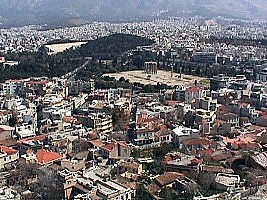 My favourite spot is at the flag where Athens stretches out endlessly below. You can see the Plaka beneath you, the ruins of the giant Temple of Olympian Zeus and the Olympic stadium nestled in a pine covered hill, an island of green in a sea of concrete. To the left of the stadium is the Zappion building and the National Gardens. To the right of the stadium you can see another large patch of green which is the First Cemetery. The Acropolis is a great place to get your bearings and get an understanding of the layout of the city. In fact the more you know Athens the more interesting it is to come up here and see familiar landmarks.
My favourite spot is at the flag where Athens stretches out endlessly below. You can see the Plaka beneath you, the ruins of the giant Temple of Olympian Zeus and the Olympic stadium nestled in a pine covered hill, an island of green in a sea of concrete. To the left of the stadium is the Zappion building and the National Gardens. To the right of the stadium you can see another large patch of green which is the First Cemetery. The Acropolis is a great place to get your bearings and get an understanding of the layout of the city. In fact the more you know Athens the more interesting it is to come up here and see familiar landmarks.
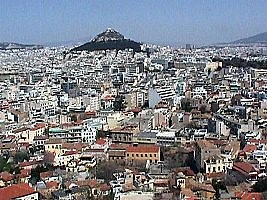 If you stand by the flag and look to your left you will see Mount Lycabettos rising from the neighbourhood of Kolonaki , with the Hilton and the Athens Tower at Ambelokipi in the distance. The large green area is the National gardens. The Acropolis is a great place to get your bearings in Ath
ens. Y
ou can see as far as Kifissia on a clear day.
If you stand by the flag and look to your left you will see Mount Lycabettos rising from the neighbourhood of Kolonaki , with the Hilton and the Athens Tower at Ambelokipi in the distance. The large green area is the National gardens. The Acropolis is a great place to get your bearings in Ath
ens. Y
ou can see as far as Kifissia on a clear day.
When the Germans occupied Athens in WWII, the Evzone who guarded the Greek flag which flew from the Acropolis, was ordered by the Nazis to remove it. He calmly took it down, wrapped himself in it and jumped to his death.
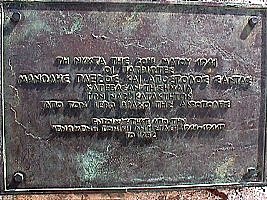 The plaque by the flag commemorates Manolis Glezos and Apostolis Santas, the two eighteen year-old heroes who tore down the Nazi flag flying from the Acropolis on the night of May 30th, 1941. It is of particular interest because these names are known not only by Greeks, but by many Europeans, because this act of courage and resistance to Nazi oppression was an inspiration to all subjected people. Later through reading the book Athens: The City by John Tomkinson I found out that Glezos, who became a member of the Greek resistance, was condemned to death for treason in 1948 and imprisoned for being a communist. He was later elected a member of the Panhellenic Socialist Party (PASOK).
The plaque by the flag commemorates Manolis Glezos and Apostolis Santas, the two eighteen year-old heroes who tore down the Nazi flag flying from the Acropolis on the night of May 30th, 1941. It is of particular interest because these names are known not only by Greeks, but by many Europeans, because this act of courage and resistance to Nazi oppression was an inspiration to all subjected people. Later through reading the book Athens: The City by John Tomkinson I found out that Glezos, who became a member of the Greek resistance, was condemned to death for treason in 1948 and imprisoned for being a communist. He was later elected a member of the Panhellenic Socialist Party (PASOK).
 Below the Acropolis is the theatre of Herod Atticus built by the Romans in 161 AD and still used today for classical concerts, ballet, performances of high cultural value and Yanni. Further on is the Theatre of Dionysius the first stone theatre and home to Sophocles, Aeschylus, Euripides and Aristophanes. It was rebuilt around 342 BC by Lykourgos and then enlarged by the Romans to be used for gladiator fights. In July of 2003 I saw Jethro Tull here. It was the first rock concert held in the ancient theatre and though perhaps some people hope it was the last I would be happy to see more. How about Deep Purple with the Royal Philharmonic Orchestra performing Jon Lord's Concerto for Group and Orchestra? Maybe Procul Harum? Emerson, Lake and Palmer? The Stooges? Where's Leonard Cohen when you really need him?
Below the Acropolis is the theatre of Herod Atticus built by the Romans in 161 AD and still used today for classical concerts, ballet, performances of high cultural value and Yanni. Further on is the Theatre of Dionysius the first stone theatre and home to Sophocles, Aeschylus, Euripides and Aristophanes. It was rebuilt around 342 BC by Lykourgos and then enlarged by the Romans to be used for gladiator fights. In July of 2003 I saw Jethro Tull here. It was the first rock concert held in the ancient theatre and though perhaps some people hope it was the last I would be happy to see more. How about Deep Purple with the Royal Philharmonic Orchestra performing Jon Lord's Concerto for Group and Orchestra? Maybe Procul Harum? Emerson, Lake and Palmer? The Stooges? Where's Leonard Cohen when you really need him?
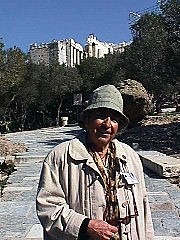 You may notice at the entrance to the Acropolis and the paths leading up to it the licensed guides who for around 50 Euros or so, will give you a tour so that you may leave the area more informed then when you got here. One of the most well-known was Teresa Mitsopoulou, an Archaeologist and writer of some renown. Several of her books are considered controversial by her fellow archaeologists because they seem to prove a link between Chinese and Ancient Greek culture that if correct could change much of what we believe about the past. Theresa has gotten older now and cannot climb the ancient hill as quickly and as easily as she once used to. But she has been described by one travel agent as “… to the Parthenon, what an old monk is to a monastery. If one has the time and patience to sit with her much can be gained. She has been a licensed Acropolis Guide since 1954, in my view a contemporary priestess”. See Theresa's website at www.greecetravel.com/archaeology/mitsopoulou
You may notice at the entrance to the Acropolis and the paths leading up to it the licensed guides who for around 50 Euros or so, will give you a tour so that you may leave the area more informed then when you got here. One of the most well-known was Teresa Mitsopoulou, an Archaeologist and writer of some renown. Several of her books are considered controversial by her fellow archaeologists because they seem to prove a link between Chinese and Ancient Greek culture that if correct could change much of what we believe about the past. Theresa has gotten older now and cannot climb the ancient hill as quickly and as easily as she once used to. But she has been described by one travel agent as “… to the Parthenon, what an old monk is to a monastery. If one has the time and patience to sit with her much can be gained. She has been a licensed Acropolis Guide since 1954, in my view a contemporary priestess”. See Theresa's website at www.greecetravel.com/archaeology/mitsopoulou
Acropolis Information
The Acropolis is open from 8am to 6:30 pm every day. These hours can change depending on the season and sometimes it is open in the evening of the full moon in the summer. They don't allow you to bring backpacks or day bags on the Acropolis. You have to check them so if you need to bring a bag with you be sure to have a spare pocket for your valuables. The cost of entrance to the Acropolis is about 12 euros and is good for the other sites in the area including the ancient agora, theatre of Dionysos, Kerameikos, Roman Agora, Tower of the Winds and the Temple of Olympian Zeus and is supposedly good for a week. You can also buy individual tickets to these other sites. One way to get to the Acropolis is to walk up from the Plaka and keep climbing until you come to the small road that goes around it and head west (to your right). The entrance is up from the rock of Areopagos. The easiest way is to follow Dioysiou Aeropagitou, the large pedestrian street that starts near Hadrian's Arch and goes around the north of the Acropolis until you come to the marble paths that lead up the hill. This road becomes Apostolou Pavlou which is also car-less and continues past the cafes of Thission to the lower Ermou and Kerameikos archaeological site which is at the bottom of Monastiraki.
Matt Barrett is a travel writer who specializes in Greece. His Greece Travel Guides at www.greecetravel.com are considered among the best on the internet with enthralling photos and entertaining writing while at the same time being very informative. He also answers questions about Greece by e-mail at matt@greecetravel.com
